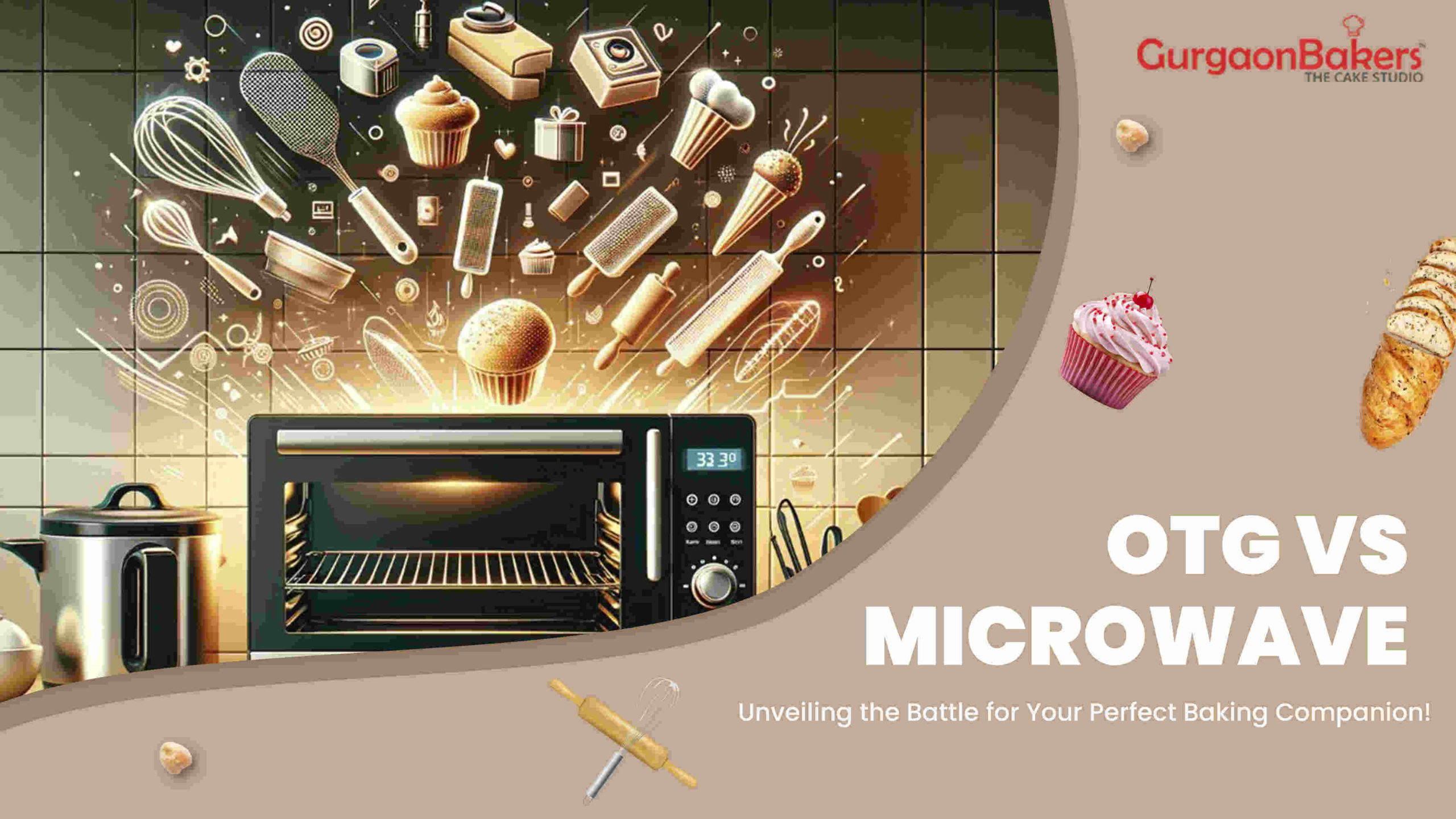For home bakers, the oven is the heart of the kitchen—a sacred space where ingredients come together to create magic. Yet, in today’s technologically advanced culinary world, a new dilemma has emerged: the choice between baking in a traditional Oven Toaster Grill (OTG) or a modern microwave oven. This decision isn’t merely about preference; it’s about understanding the nuanced functionalities and the outcomes they produce in baked goods.
The OTG, revered for its precision and consistency, is often pitted against the microwave, a champion of convenience and speed. The OTG harks back to classic baking techniques, offering a sense of control with its steady heat, while the microwave represents the brisk pace of modern life, promising quick results with the push of a button. The debate between the two is not just a culinary crossroads but a junction of tradition and innovation.
Choosing the right appliance is crucial, as it can significantly affect the texture, flavor, and overall quality of the baked masterpiece. Whether it’s the golden crust of a freshly baked sourdough or the moist crumb of a chocolate cake, each baker’s quest is to achieve perfection. Understanding the inherent capabilities of both OTGs and microwaves is essential to making an informed decision, one that aligns with the baker’s goals, be they the artistry of baking or the efficiency of the process.
In this exploration of OTG versus microwave baking, we will delve into the merits and limitations of each, equipping you with the knowledge to choose the best baking ally. Because in the end, every home baker seeks to create something that not only looks delightful but tastes as if it’s been crafted with the utmost care and wisdom—a treat that resonates with the love for baking.
Understanding OTGs and Microwaves
OTGs (Oven Toaster Grill):

An Oven Toaster Grill, commonly known as an OTG, is a versatile kitchen appliance that caters to a baker’s creativity and precision. It operates on the fundamental principle of traditional baking, where electric coils heat the oven’s interior and cook the food through radiant heat transfer. The thermostat within regulates the temperature, providing an even cooking environment that’s ideal for a wide array of baked goods.
Typically, an OTG is equipped with heating elements both on the roof and the floor of the oven cavity, which can be independently controlled. This allows bakers to either broil, bake, or toast, hence the name. The slow and steady nature of the heat makes OTGs perfect for intricate baking tasks—from the flaky layers of a croissant to the delicate sponge of an angel food cake. Furthermore, the inclusion of a convection feature in some OTGs enhances the even distribution of heat, reducing cooking times and saving energy while maintaining the desired fluffiness and crust in baked products.
Microwave Ovens:
On the other end of the spectrum lies the microwave oven, a product of modern convenience and speed. Microwaves cook food using electromagnetic radiation, which excites water molecules in the food, causing them to heat up and, as a result, cook the food from the inside out. This technology revolutionizes the way we think about cooking, drastically reducing the time it takes to heat and cook food.
Microwaves are not traditionally associated with baking; however, their technology has advanced to include convection microwave ovens that combine the quick heating of microwaves with the baking capabilities of an oven. These dual-function appliances allow home bakers to enjoy the expedience of microwaving with the ability to bake and roast as well. While a standard microwave is excellent for reheating and cooking food quickly, a convection microwave can be used to bake cookies, cakes, and other pastries, though often with a different texture and crust compared to conventional ovens.
Both OTGs and microwave ovens have their place in the modern kitchen, serving different needs and preferences. Understanding how each functions is the first step in determining which appliance best suits your baking adventures.
Baking in an OTG
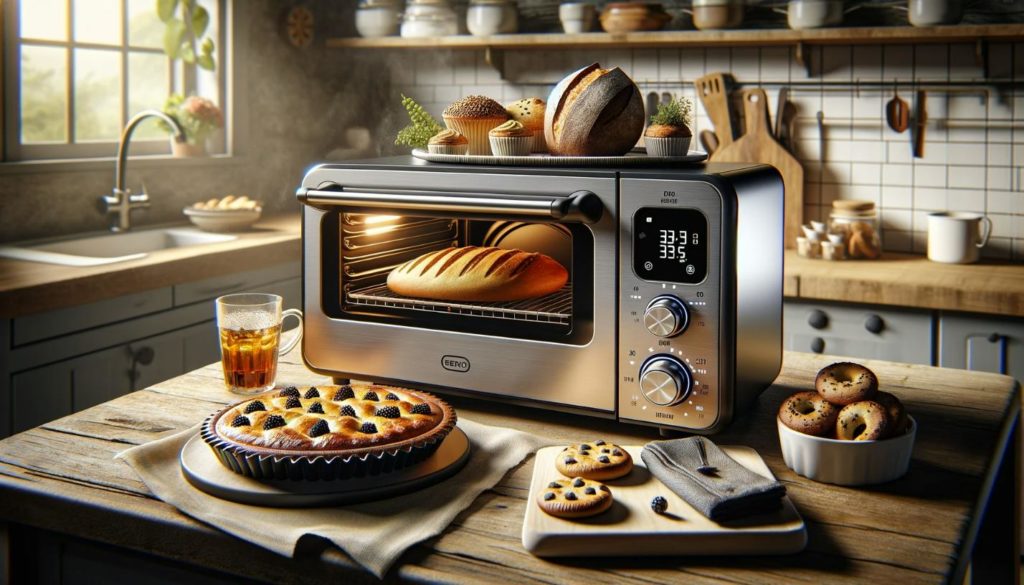
Even Cooking and Browning
- OTGs are celebrated for their ability to distribute heat evenly, which is a cornerstone for successful baking. The heating elements located at the top and bottom of the oven cavity provide consistent and uniform heat.
- This even heat distribution is essential for achieving a uniform color and perfect browning on baked goods, be it bread, pastries, or cakes.
- The heat envelops the baking tray in a consistent temperature, eliminating hot spots that can cause uneven baking.
Temperature Control
- One of the key strengths of an OTG is the precision of temperature control. Home bakers can set the exact temperature required for their recipe, which is crucial for delicate baked goods.
- Most OTGs come with a thermostat that regulates the temperature, ensuring it remains steady throughout the baking process. This precision aids in predictable and reliable baking results.
- The ability to control temperature precisely also means that recipes can be replicated with consistency, an important factor for bakers who value uniformity in their creations.
Versatility
- OTGs are not just limited to baking; they offer a wide range of culinary possibilities:
- Baking: Ideal for cakes, cookies, pies, and bread, offering the right environment for rising and browning.
- Grilling: Perfect for grilling vegetables, meats, and paneer, providing that distinct charred flavor.
- Toasting: Excellent for making toast, garlic bread, or even roasting nuts and seeds.
- This versatility makes an OTG a valuable tool for home bakers who enjoy experimenting with a variety of baking and cooking methods.
Baking in a Microwave
Speed
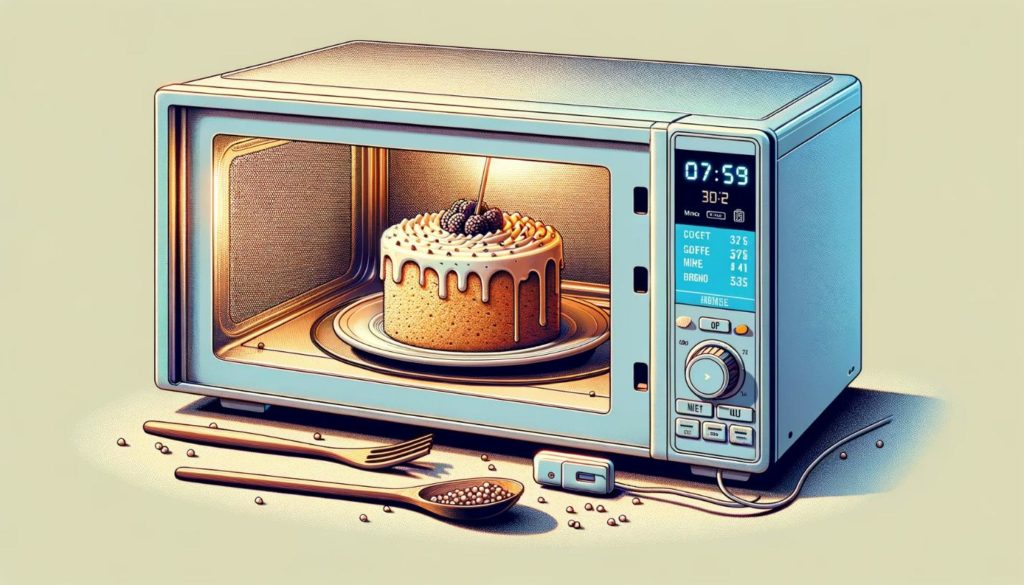
- The primary advantage of using a microwave for baking is its speed. Microwaves cook food significantly faster than conventional ovens by using electromagnetic radiation, which heats the water molecules in food, causing them to vibrate and produce heat.
- This rapid cooking is particularly advantageous for recipes that would typically take a long time in a traditional oven, such as certain types of cakes or bread.
- The quick baking time in a microwave is ideal for bakers who are short on time but still want to enjoy homemade baked goods.
Convenience
- Microwaves are often praised for their convenience. The simple push of a button can set the appliance to the desired setting and time, eliminating the need for preheating, which is essential in traditional baking.
- Their compact size makes them a suitable option for small kitchens or for people who do not bake frequently enough to justify the space an OTG occupies.
- Many modern microwaves come with preset baking functions, making it easier for even novice bakers to start baking with minimal effort.
Limitations
- While microwaves offer speed and convenience, they do have limitations, particularly when it comes to baking:
- Uneven Cooking: Due to the way microwaves heat food, they can sometimes cook unevenly. This can be problematic for baked goods that require consistent heat distribution.
- Lack of Browning: Microwaves cannot brown or crisp the exterior of baked goods in the same way a conventional oven can. This results in a different texture and appearance of the baked product.
- Limited Size: The cavity of a microwave oven is generally smaller than that of an OTG, limiting the size of the baked goods that can be prepared.
Understanding these limitations is crucial for home bakers to set realistic expectations when using a microwave for their baking projects.
Pros and Cons
OTG Pros and Cons
| Pros of OTG | Cons of OTG |
|---|---|
| Even Heat Distribution: Ideal for uniform baking and browning, ensuring consistent quality. | Longer Preheating Time: Requires time to reach the desired temperature. |
| Precise Temperature Control: Allows for accurate baking settings, crucial for delicate recipes. | Size and Space: Generally larger, requiring more kitchen space. |
| Versatility: Suitable for a variety of baking, grilling, and toasting needs. | Energy Consumption: Can consume more electricity due to longer operation times. |
| Quality of Bake: Tends to produce superior texture and crust in baked goods. | Learning Curve: Might take time for beginners to master temperature and settings. |
Microwave Pros and Cons
| Pros of Microwave | Cons of Microwave |
|---|---|
| Speed: Rapid cooking and baking times, ideal for quick baking needs. | Uneven Cooking: Can lead to hot spots and unevenly baked goods. |
| Convenience: Easy to use with preset functions and minimal preheating required. | No Browning: Lacks the capability to brown or crisp the exterior of baked goods. |
| Compact Size: Takes up less space, suitable for smaller kitchens. | Limited Baking: Not ideal for complex baking tasks or large batches. |
| Energy Efficiency: Generally consumes less electricity due to shorter operation times. | Texture Differences: May produce a different texture in baked goods compared to traditional ovens. |
Comparing OTG and Microwave Baking Results
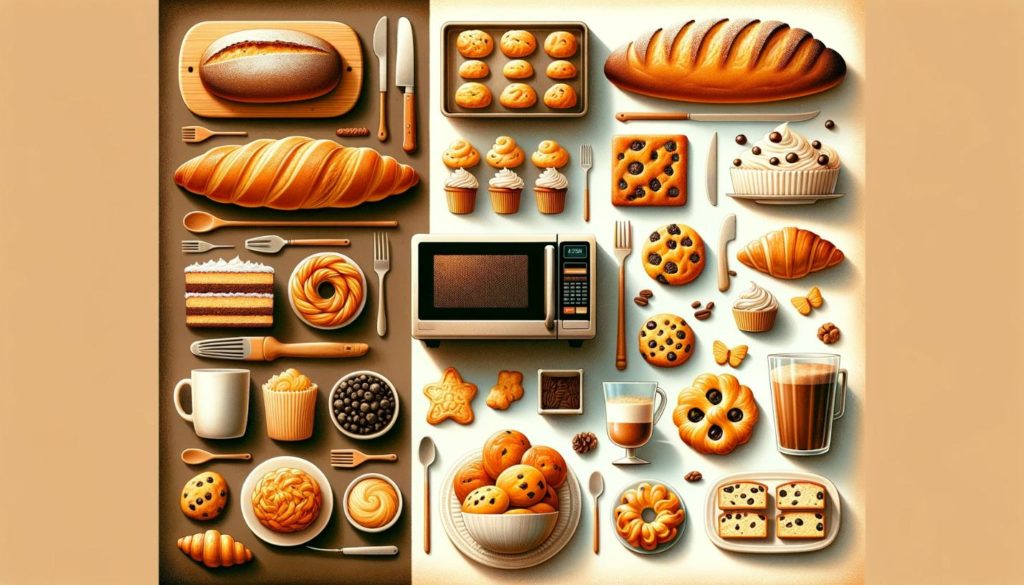
Texture and Quality Comparison
| Aspect | OTG Results | Microwave Results |
|---|---|---|
| Texture | Produces a more traditional texture with a crisp exterior and soft interior. Ideal for breads and pastries. | Often results in a softer, more moist texture. Suitable for quick breads and cakes. |
| Quality of Bake | Even baking with superior browning and crust formation, giving a professional finish. | Can lack the evenness and browning of an OTG, potentially affecting the final appearance. |
| Consistency | Reliable and consistent results due to precise temperature control. | Can vary, particularly in thicker items, due to uneven heating. |
| Versatility | Capable of handling a wide range of baking needs from delicate pastries to hearty breads. | Best for simple, quick baking tasks. Not ideal for complex or layered baked goods. |
Best Suited Baked Goods
| Baked Goods | Best in OTG | Best in Microwave |
|---|---|---|
| Cakes | Layered cakes, cheesecakes, and cakes requiring a crispy crust. | Single-layer cakes, mug cakes, or cakes with a moist texture. |
| Breads | Artisan breads, sourdough, baguettes, and other crusty breads. | Quick breads like banana bread or simple loaves that don’t require a crust. |
| Pastries | Croissants, puff pastries, and pastries requiring flakiness. | Simple pastries that are more about the filling than the dough texture. |
| Cookies | Traditional cookies like chocolate chip or oatmeal that need a crisp edge. | Soft-baked cookies or cookie bars that benefit from a chewy texture. |
| Pies and Tarts | Pies and tarts where a crispy crust is essential. | Not recommended for pies or tarts as microwaves cannot achieve the required crust texture. |
Making the Right Choice for Your Baking Needs

Considerations for Home Bakers When selecting between an OTG and a microwave for home baking, several factors need to be considered to ensure the choice aligns with your baking style and kitchen requirements:
- Types of Baking: Reflect on what you bake most often. If you enjoy making artisan breads, layered cakes, or pastries requiring a crispy crust, an OTG is your go-to. For quick breads, mug cakes, and simple baked goods, a microwave might suffice.
- Kitchen Space: Evaluate the space in your kitchen. OTGs require more space and are suitable for larger kitchens, whereas microwaves are compact and ideal for smaller spaces.
- Budget: Consider your budget. Generally, OTGs can be more expensive than microwaves, but they offer a wider range of baking options.
- Frequency of Use: If you bake frequently and experiment with various recipes, an OTG might be a better investment. For occasional, simple baking, a microwave could be more practical.
Skill Level: Beginners might find microwaves easier to start with due to their simplicity, while experienced bakers might prefer the control and versatility of an OTG.
Expert Opinions
- Experts in the field of baking and culinary arts have varying opinions on the effectiveness of OTGs and microwaves:
- Many professional bakers advocate for OTGs due to their ability to produce superior texture and consistency in baked goods.
- Culinary instructors often recommend OTGs for students serious about baking, as they mimic the conditions of professional baking ovens.
- Some kitchen appliance experts highlight the advances in microwave technology, such as convection microwaves that offer both speed and baking capabilities.
- Nutritionists sometimes prefer microwave baking for its ability to retain more nutrients due to shorter cooking times.
Ultimately, the decision between an OTG and a microwave for home baking depends on individual preferences, needs, and the kind of baking you plan to do. It’s about finding the right balance between functionality, convenience, and the joy of baking.
Tips for Optimizing Baking in Both OTG and Microwave
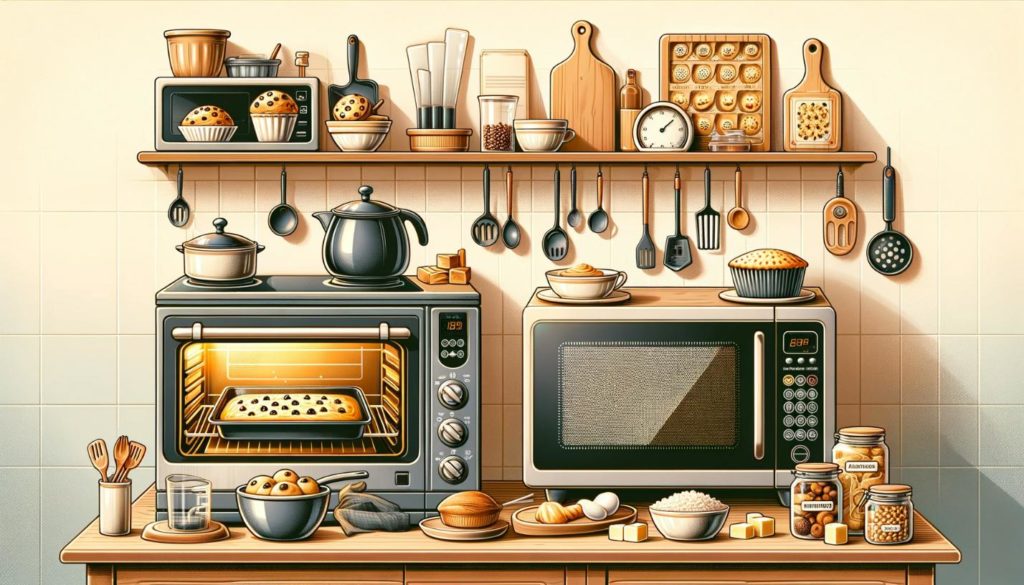
- Preheat Your OTG: Always preheat your OTG to the desired temperature before baking. This ensures a consistent temperature throughout the baking process.
- Use the Right Bakeware: Opt for bakeware that’s appropriate for an OTG. Dark or non-stick pans are great for browning, while glass or ceramic works well for even heat distribution.
- Rotate Your Baking Tray: Halfway through the baking time, rotate your tray to ensure even baking, especially if your OTG has hot spots.
- Monitor the Temperature: Use an oven thermometer to double-check the accuracy of your OTG’s temperature settings.
- Utilize Baking Modes: If your OTG has different modes (like convection), use them according to the recipe requirements for optimal results.
- Avoid Frequent Door Opening: Keep the door closed as much as possible to maintain a consistent temperature inside the OTG.
- Use Microwave-Safe Bakeware: Always use containers that are labeled as microwave-safe to avoid any health hazards or damage to your microwave.
- Reduce the Power Setting: Bake on a lower power setting (around 70-80%) to avoid overcooking or uneven cooking of your baked goods.
- Even Distribution of Ingredients: Spread the batter evenly in the dish to promote uniform cooking, as microwaves can sometimes cook unevenly.
- Use Standing Time: After baking, let your baked goods stand inside the microwave for a few minutes. The residual heat continues to cook and set the bake.
- Experiment with Timing: Since microwave ovens vary, it might take a few trials to get the timing right. Start with the lowest time suggested and add time as needed.
- Cover Your Bake: To prevent the top from drying out, cover your baking container with a microwave-safe lid or vented plastic wrap.
As we reach the end of our exploration into the world of home baking with OTGs and microwaves, it’s clear that each appliance has its unique strengths and limitations. The Oven Toaster Grill (OTG) stands out for its even heat distribution, precise temperature control, and versatility, making it a preferred choice for intricate and traditional baking. On the other hand, the microwave oven shines with its unmatched speed, convenience, and compact size, suitable for quick, simple baking tasks.
The decision between an OTG and a microwave ultimately boils down to your specific baking needs, kitchen space, budget, and personal preferences. If you revel in the art of baking and desire professional-quality results, an OTG may be your ideal partner. However, if you’re pressed for time and space, seeking quick and convenient baking solutions, then a microwave could be the way to go.
Remember, the right appliance is the one that aligns with your baking style and culinary ambitions. Whether it’s the traditional approach of an OTG or the modern convenience of a microwave, each offers a unique way to express your love for baking. We hope this article has provided you with valuable insights to guide your choice, helping you make informed decisions to elevate your baking journey.
Happy baking!

